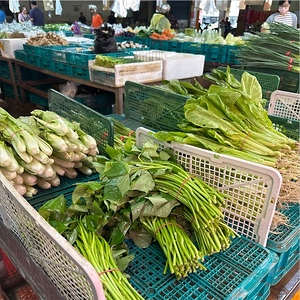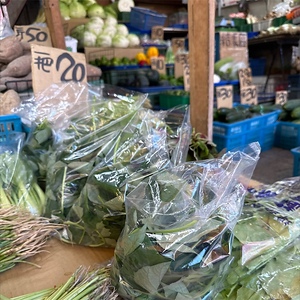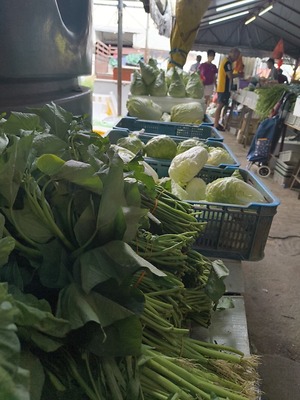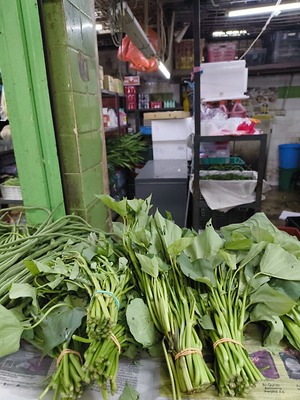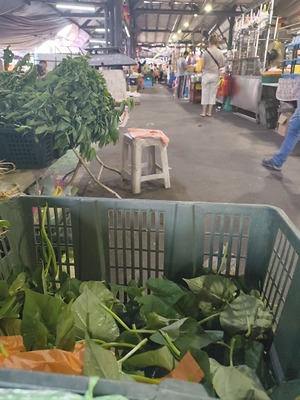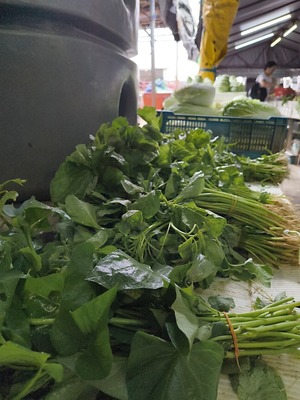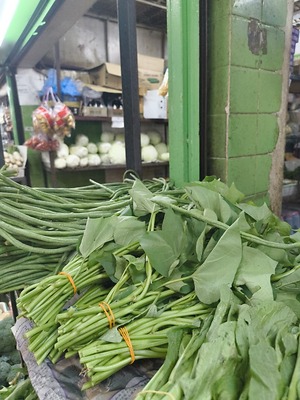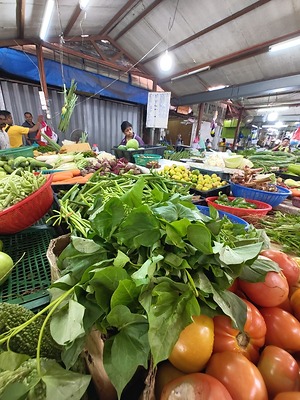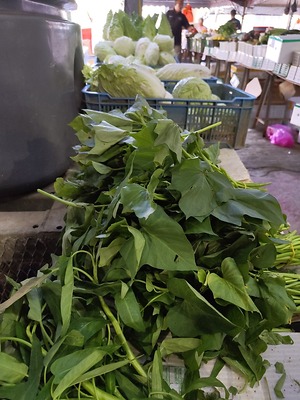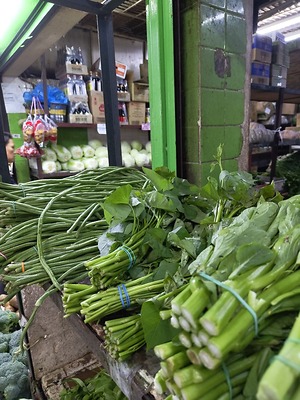

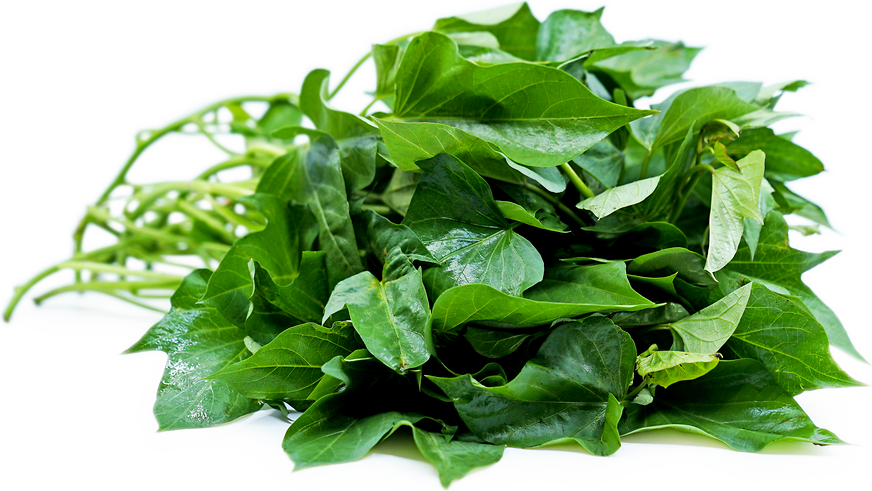
Sweet Potato Leaves
Estimated Inventory, lb : 0
Description/Taste
Sweet potato leaves vary in size and shape, depending on the specific variety and age at harvest. The leaves appear heart-shaped, triangular, round, or tapered, and some varieties have multiple lobes ending in pointed tips. Sweet potato leaves grow upright and have a pliable, floppy, and delicate nature, being easily torn or broken. The leaf’s surface is typically covered in prominent, branching veining, giving the surface a rugged to slightly crinkled feel. The leaves also range in color from purple, yellow-green, bright green, to dark green, depending on the variety. Most leaves will be lighter on their undersides and bear lighter-colored stems. The stems are firm, crisp, aqueous, and snappy with a succulent consistency. Once cooked, the stems and leaves become soft, tender, and subtly chewy. A few varieties may also have a slippery texture. Sweet potato leaves are edible raw but often bear a bitter taste. Worldwide, they are mainly preferred to be cooked to mellow their flavor and texture. The leaves have a mild, vegetal, sweet, subtly bitter, and neutral taste reminiscent of cooked spinach.
Seasons/Availability
Sweet potato leaves are available year-round, with a peak season from April to November.
Current Facts
Sweet potato leaves, botanically classified as Ipomoea batatas, are the foliage of an herbaceous perennial belonging to the Convolvulaceae family. Historically, Sweet potato plants have been grown worldwide for their underground tubers, but their leaves are a secondary crop that has become a prized culinary ingredient for their versatility and nutritional properties. Sweet potato leaves can be harvested approximately 45 to 90 days after planting, and the leaves are collected as needed, extending their availability and season length. The greens are well-known among communities worldwide, especially throughout Asia and Africa, and are known by many names, including Yam leaves, Dìguā yè in Chinese, Kandaba and Kazura in Japanese, Goguma-Sun and Goguma-Julgi in Korean, Bai Man-Tet in Thai, and Rau Lang in Vietnamese. In Africa, the leaves are called Plasas, Petehteh, Lumonda, and Sukaali. Sweet potato leaves are commercially cultivated and sown in home gardens and are sold through local markets in their growing regions. The leaves are traditionally sold fresh or dried for culinary purposes and utilized in various raw or cooked savory dishes.
Nutritional Value
Sweet potato leaves are a source of vitamins A, B, C, E, and K to strengthen the immune system, aid the body in energy production, maintain healthy organs, and guard the cells against the damage caused by free radicals. Sweet potato leaves also provide fiber to regulate the digestive tract, and minerals like calcium, phosphorus, iron, potassium, magnesium, zinc, and manganese. Calcium and phosphorus help the body protect bones and teeth, iron develops the protein hemoglobin for oxygen transport through the bloodstream, and potassium balances fluid levels within the body. Magnesium assists the body in controlling nerve operations, manganese helps with metabolism, and zinc promotes wound healing. In natural medicines practiced throughout Asia, Sweet potato leaves are believed to help coat the stomach, lubricate the digestive tract for protection against acids, and encourage healthy bowel movements. The greens are often referred to as a “longevity vegetable” and have anti-inflammatory and antioxidant properties to contribute to overall bodily health.
Applications
Sweet potato leaves have a mild, vegetal, and subtly bitter flavor suited for fresh and cooked preparations. Before cooking, the leaves should be washed well. Sweet potato leaves are edible raw, but their taste can be somewhat bitter and are primarily preferred for cooking. It is also important to note that the leaves may discolor and sometimes turn black due to their high iron content when cooked. This can be lessened with lemon juice or blanching the greens and mixing them with soy sauce to add a different color to the dish. Depending on the cooking method, they can also develop a slightly mucilaginous consistency. In Asia, Sweet potato leaves are primarily stir-fried or blanched. Each country has varying ingredients combined with the leaves for enhanced flavoring, but garlic, shallots, and ginger are universal pairings for the greens. In China and Taiwan, Sweet potato leaves are often served with minced pork or tossed in soy sauce. The greens are also simmered into soups, porridges, and curries in Vietnam or added to omelets and dumpling fillings. In Japan, Sweet potato leaves are blended into smoothies, incorporated into bread, fried into tempura, or used as a wrap for meat. The leaves are also mixed into noodle and rice dishes across Asia. In Korea, Sweet potato stems are a favored culinary ingredient and are added to a stew-like bean paste dish or served with rice. Outside East Asia, Sweet potato leaves are commonly simmered in soups and stews in Africa and minced into raita in India. They are also incorporated as simple greens in dishes in the South Pacific and the Americas. Sweet potato leaves pair well with meats such as poultry, beef, pork, or fish, red bell peppers, tomatoes, broccoli, mushrooms, and water chestnuts. The leaves are highly perishable and should be immediately consumed for the best quality and flavor. Sweet potato leaves will only keep for a few days, depending on their age, when loosely wrapped in a damp paper towel and stored in a loose bag in the refrigerator. The leaves are also dried for extended use.
Ethnic/Cultural Info
Sweet potato leaves are famously used in huguocai, a traditional dish from Chaoshan, a region in the eastern Guangdong Province of China. The historical dish dates back to the Song Dynasty when legend claims that Emperor Zhao Bing fled from Fuzhou and hid in the mountains from the Yuan army sometime around 1278 CE. The emperor took refuge in the Taiping Temple on the Fenghuang Mountain near Chaoshan. While the emperor hid, the temple monks wanted to show their respect and provide him with a nourishing meal. Since it was during a time of war, crops were scarce, and the only ingredients the monks could find were locally foraged greens and a few other vegetables. The monks made these ingredients into a soup. The emperor was thankful for the dish and named it huguocai, roughly meaning the “National Protection Dish.” Huguocai became a dish in honor of the Song Dynasty and is also sometimes called the “Emperor’s Dish.” It is unknown what greens were initially used for the dish in the story of the Song Dynasty, but when Sweet potato leaves were introduced during the Ming Dynasty, they became the signature ingredient that gave the dish its colorful green hue.
Geography/History
Sweet potato leaves are native to the Americas and have been growing wild since ancient times. The species has been planted as a culinary crop for several centuries and is grown for its edible tubers and leaves. There is some debate surrounding the species’ introduction to the rest of the world. Some sources claim that the Polynesians carried Sweet potatoes from the Americas to Asia around 1100 CE. This is the earliest proposed arrival of the species. Sweet potatoes were later introduced to Europe and Asia through the Spanish and Portuguese in the 16th century. Sweet potatoes were spread via trade routes and were first planted in China sometime during the Ming Dynasty, from 1368 to 1644 CE. They were later sown throughout East Asia and became a valued crop for human and animal consumption. Sweet potato leaves are mostly regarded as a secondary crop to the tubers. Throughout history, the leaves have had varying reputations worldwide, from food for low-income families and livestock to a treasured, local, and nutritional green. In the 20th century, the leaves began to be promoted as a nutritious standalone culinary ingredient, leading Sweet potato leaves to become a popular commercial crop. New varieties were also selectively bred exclusively for their edible leaves. Today, Sweet potato leaves are cultivated worldwide, with concentrated production in Asia, Africa, the South Pacific, and the Americas. The leaves are sold fresh through local markets, supermarkets, and select distributors.
Recipe Ideas
Recipes that include Sweet Potato Leaves. One



